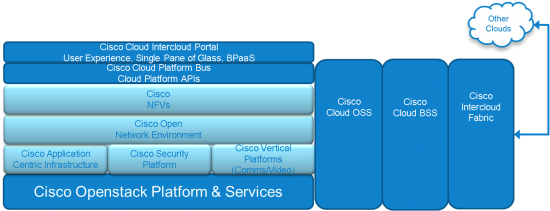Over the past weeks, Cisco Cloud Services introduce a global Intercloud . Today I’d like to explain how Cisco Intercloud provides a platform for Cisco, ISVs, and partners application enablement and innovation.
Infrastructure as service (IaaS) is a very small part of the overall cloud adaption requirements needed to enable business agility, growth, and transformation. This is an area that service providers and Telcos have been trying to optimize with traditional BSS, OSS, and provisioning systems over the last several years. The overall market for cloud in these providers is very small and not growing quickly due to their lack of development and application enablement in the physical and virtual layers. These layers are becoming commodity capabilities and not easy to differentiate business capabilities on without adding tremendous cost from enterprise software and advanced services. Even with this added cost, enterprises are failing to transform because basic IaaS is a very small part of their overall business needs.

This is not to say that IaaS does not matter. Where IaaS matters is their efficiency and platform capabilities that enable businesses to innovate seamlessly. In addition, cost models and SLA are very important to businesses.
Consider the electric power to your home and office. Typically you do not worry about the quality and performance of that power. You do not call up the power company and ask for the power plants specs and performance characteristics. It’s a utility and you use it. For the most part, it is reliable and available. The importance in building a cloud application enablement platform is to have a utility model mindset and ensure the platform is efficient, scalable, and 100% interoperability across other cloud solutions including PaaS and SaaS. There is too much focus on IaaS which is just a very small part of the overall foundation. If you want to understand more information on Cisco’s Intercloud platform please read my blog Open and Interoperable. See the figure below for a view the IaaS Platform.

For application enablement and development, it is critical to have an open scalable platform. This aspect is not “magic” as many cloud service providers and Telco’s might have you believe. Many are still at the phase of trying to just get the basic hardware and software operating with their traditional OSS and BSS. The industry has settled on open source platforms and the leaders here are Cloud Foundry and OpenShift, but the platform characteristics are what’s important to understand.
The industry has settled on Application Platform as a Service (aPaaS) and Integration Platform as a Service (iPaaS). aPaaS represents the cloud services that offer development and deployment environments for application services. These services must be interoperable across cloud service provider boundaries. The main goal of this platform must be to support open standard libraries, services, monitoring, and deployment capabilities. This is accomplished through open common development libraries. iPaaS is represented by a suite of services that enable development, execution, governance, workflow integration, and policy controls. Both aPaaS and iPaaS provide the following capabilities:
- Mutli-tenant Services
- High Availability (HA) A service architecture that is interoperable across multiple cloud solutions
- Middleware Stack including message bus
- Data Storage and Access
- Data Analytics
- Deployment Management (multi-vendor)
- Asynchronous processing capabilities
- Flexible Security framework i.e. integration into SecSDLC
- Data Protection
- SOA Support
- Common Management Architecture (console, log, metering, monitoring, performance)
The figure below shows the PaaS Platform:

Platform as a Service abstracts the underlying utility platform (IaaS) and presents application services, software development tools, Software libraries (Java, .Net, Ruby, node.js, etc.), and deployments environment capabilities for application design, development, testing, and deployments. To enable agility and transformation in the business, the integration of the IaaS and PaaS platforms with team collaboration, web services, database options, security, scalability, and persistent storage and compute are critical.
Lastly, the PaaS platform must include capabilities for SDLC enablement, application versioning, application management, service discovery, application service availability, and application control. The enabling element of this architecture to deliver the control and business process integration required is the Business Process as a Service (BPaaS) aspect of the Intercloud Portal. BPaaS will tie the user experience to the business process and set infrastructure application performance enforcement policies.
For more details on Cisco’s Application Control Infrastructure please see the blog ACI Design Principles and for integration with Cisco’s Intercloud please see my blog What makes Cisco Cloud Service Application Centric blog.
The integration of the PaaS platforms and IaaS platforms is critical and not straight forward. Cisco Cloud Services is on this journey and we are excited to work with are businesses, partners, and channels to provide a seamless platform for application enablement and innovation
To follow me on Twitter @kenowens12 – You can find my previous blogs on Cisco Intercloud here .
CONNECT WITH US